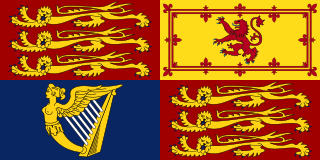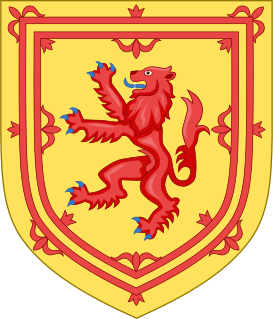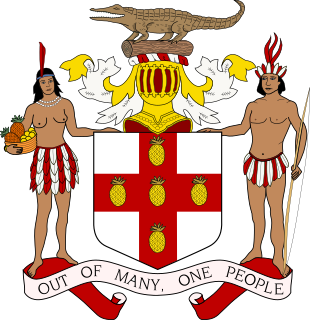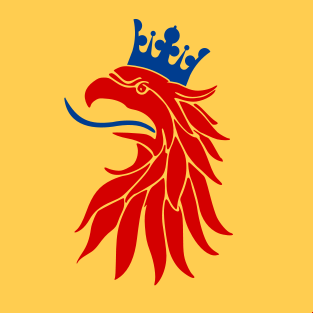
The royal coat of arms of the United Kingdom, or the Royal Arms for short, is the official coat of arms of the British monarch, currently Queen Elizabeth II. These arms are used by the Queen in her official capacity as monarch of the United Kingdom. Variants of the Royal Arms are used by other members of the British royal family; and by the British Government in connection with the administration and government of the country. In Scotland, there exists a separate version of the Royal Arms, a variant of which is used by the Scotland Office. The arms in banner form serve as basis for the monarch's official flag, known as the Royal Standard.

The Royal Standards of the United Kingdom refers to either one of two similar flags used by Queen Elizabeth II in her capacity as Sovereign of the United Kingdom and its overseas territories. Two versions of the flag exist, one for general use in England, Northern Ireland, Wales and overseas; and the other for use in Scotland.

The Royal Arms of England are the arms first adopted in a fixed form at the start of the age of heraldry as personal arms by the Plantagenet kings who ruled England from 1154. In the popular mind they have come to symbolise the nation of England, although according to heraldic usage nations do not bear arms, only persons and corporations do. The blazon of the Arms of Plantagenet is: Gules, three lions passant guardant in pale or armed and langued azure, signifying three identical gold lions with blue tongues and claws, walking past but facing the observer, arranged in a column on a red background. Although the tincture azure of tongue and claws is not cited in many blazons, they are historically a distinguishing feature of the Arms of England. This coat, designed in the High Middle Ages, has been variously combined with those of the Kings of France, Scotland, a symbol of Ireland, the House of Nassau and the Kingdom of Hanover, according to dynastic and other political changes occurring in England, but has not altered since it took a fixed form in the reign of Richard I (1189–1199), the second Plantagenet king.
The Royal Standards of Canada are a set of uniquely Canadian personal flags approved by the Queen of Canada for use by members of the Canadian Royal Family. They are used to denote the presence of the bearer within any car, ship, airplane, building, or area, within Canada or when representing Canada abroad. There are six personal royal standards, one each for the Queen, the Prince of Wales, the Duke of Cambridge, the Princess Royal, the Duke of York, and the Earl of Wessex, as well as one standard for use more generally to denote the presence of any member of the Royal Family who has not previously been provided with a specific personal standard. The flags are part of a larger collection of Canadian royal symbols.

The monarchy of New Zealand is the constitutional system of government in which a hereditary monarch is the sovereign and head of state of New Zealand. The current monarch, Queen Elizabeth II, ascended the throne on the death of her father, King George VI, on 6 February 1952.

The Head of the Commonwealth is the "symbol of the free association of independent member nations" of the Commonwealth of Nations, an intergovernmental organisation that currently comprises fifty-three sovereign states. There is no set term of office or term limit and the role itself involves no part in the day-to-day governance of any of the member states within the Commonwealth.

The Commonwealth Star is a seven-pointed star symbolising the Federation of Australia which came into force on 1 January 1901.

The coat of arms of New Zealand is the heraldic symbol representing the South Pacific island country of New Zealand. Its design reflects New Zealand's history as a bicultural nation, with a European female figure on one side and a Māori rangatira (chief) on the other. The symbols on the central shield represent New Zealand's trade, agriculture and industry, and a Crown represents New Zealand's status as a constitutional monarchy.

The royal arms of Scotland is the official coat of arms of the King of Scots first adopted in the 12th century. With the Union of the Crowns in 1603, James VI inherited the thrones of England and Ireland and thus his arms in Scotland were now quartered with the arms of England with an additional quarter for Ireland also added. Though the kingdoms of England and Scotland would share the same monarch, the distinction in heraldry used in both kingdoms was maintained. When the kingdoms of Scotland and England were united under the Acts of Union 1707 to form the United Kingdom of Great Britain, no single arms were created and instead, the royal arms as used in either Scotland and the rest of the United Kingdom would continue to differ.

The Royal Banner of the Royal Arms of Scotland, also known as the Royal Banner of Scotland, or more commonly the Lion Rampant of Scotland, and historically as the Royal Standard of Scotland, or Banner of the King of Scots, is the Royal Banner of Scotland, and historically, the Royal Standard of the Kingdom of Scotland. Used historically by the Scottish monarchs, the banner differs from Scotland's national flag, the Saltire, in that its correct use is restricted by an Act of the Parliament of Scotland to only a few Great Officers of State who officially represent the Monarchy in Scotland. It is also used in an official capacity at royal residences in Scotland when the Head of State is not present.
Canadian royal symbols are the visual and auditory identifiers of the Canadian monarchy, including the viceroys, in the country's federal and provincial jurisdictions. These may specifically distinguish organizations that derive their authority from the Crown, establishments with royal associations, or merely be ways of expressing loyal or patriotic sentiment.

In modern heraldry, a royal cypher is a monogram-like device of a country's reigning sovereign, typically consisting of the initials of the monarch's name and title, sometimes interwoven and often surmounted by a crown. Where such a cypher is used by an emperor or empress, it is called an imperial cypher. In the system used by various Commonwealth realms, the title is abbreviated as R for rex or regina. Previously, I stood for imperator or imperatrix of India. The cypher is displayed on some government buildings, impressed upon royal and state documents, and is used by government departments.

The personal flag of Queen Elizabeth II in her role as Queen of New Zealand was approved for use in 1962. It is used by the Queen only when she is in New Zealand or attending an event abroad in her role as head of state in New Zealand. The Queen's Representative, the Governor-General of New Zealand has their own flag.

The monarchy of Jamaica is a constitutional system of government in which a hereditary monarch and head of state is the sovereign of Jamaica. The terms Crown in Right of Jamaica, Her Majesty in Right of Jamaica, or The Queen in Right of Jamaica may also be used to refer to the entire executive of the government of Jamaica. Though the Jamaican Crown has its roots in the British Crown, it has evolved to become a distinctly Jamaican institution, represented by its own unique symbols.

The monarchy of Saint Lucia is a system of government in which a hereditary, constitutional monarch is the sovereign and head of state of Saint Lucia. The present monarch of Saint Lucia is Elizabeth II, who is also the Sovereign of the Commonwealth realms. The Queen's constitutional roles are mostly delegated to the Governor-General of Saint Lucia.

































